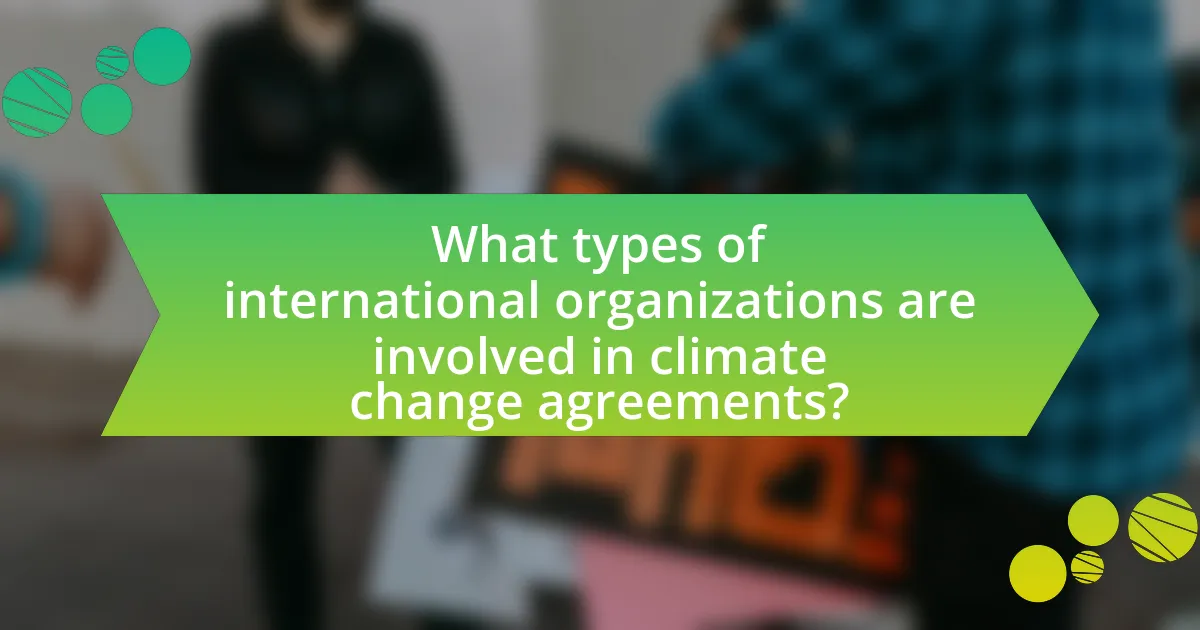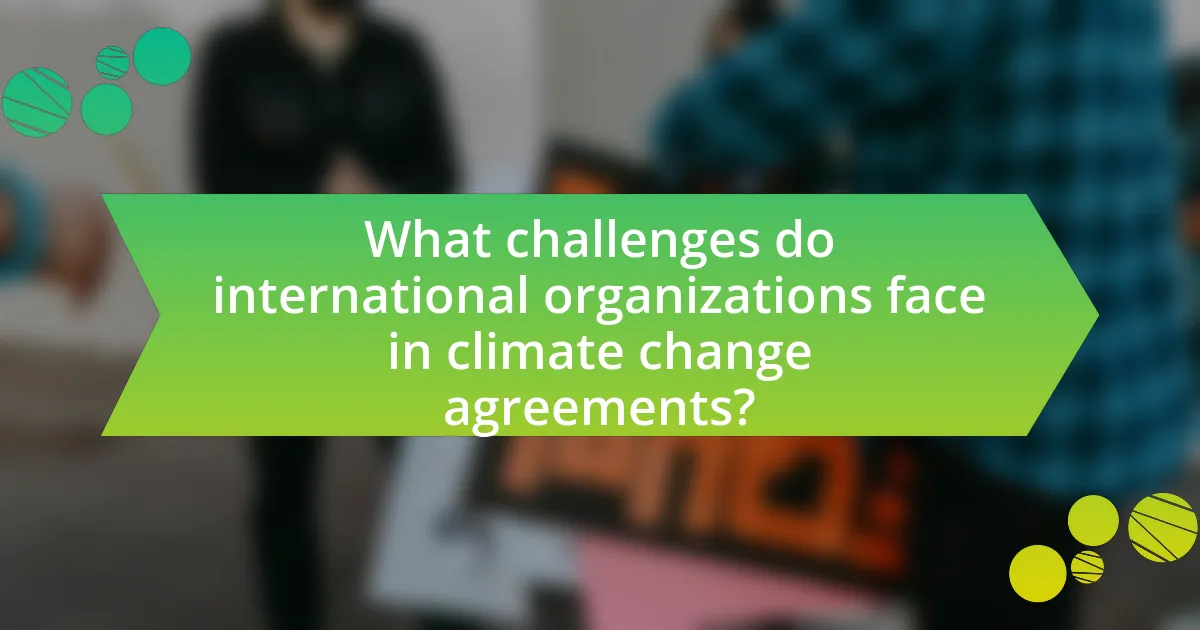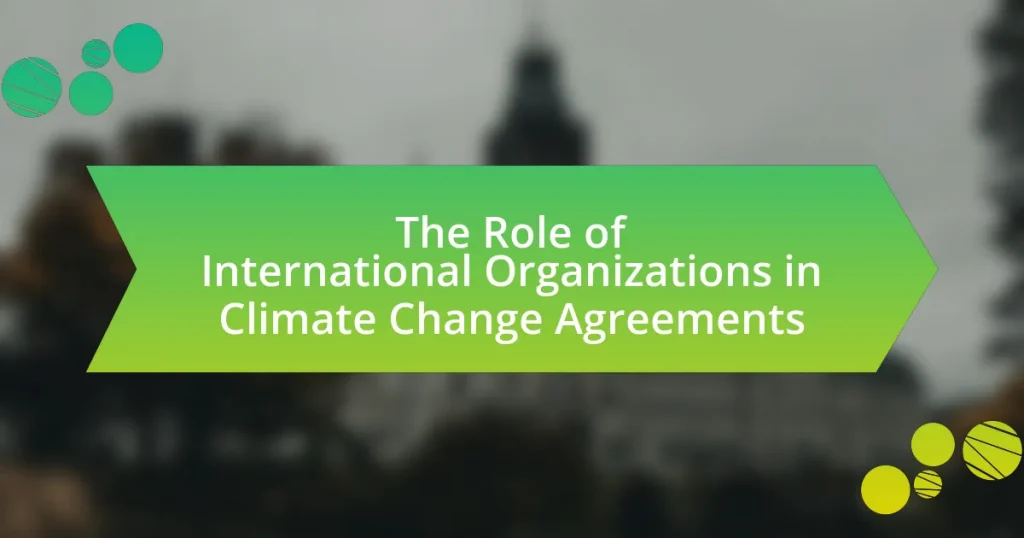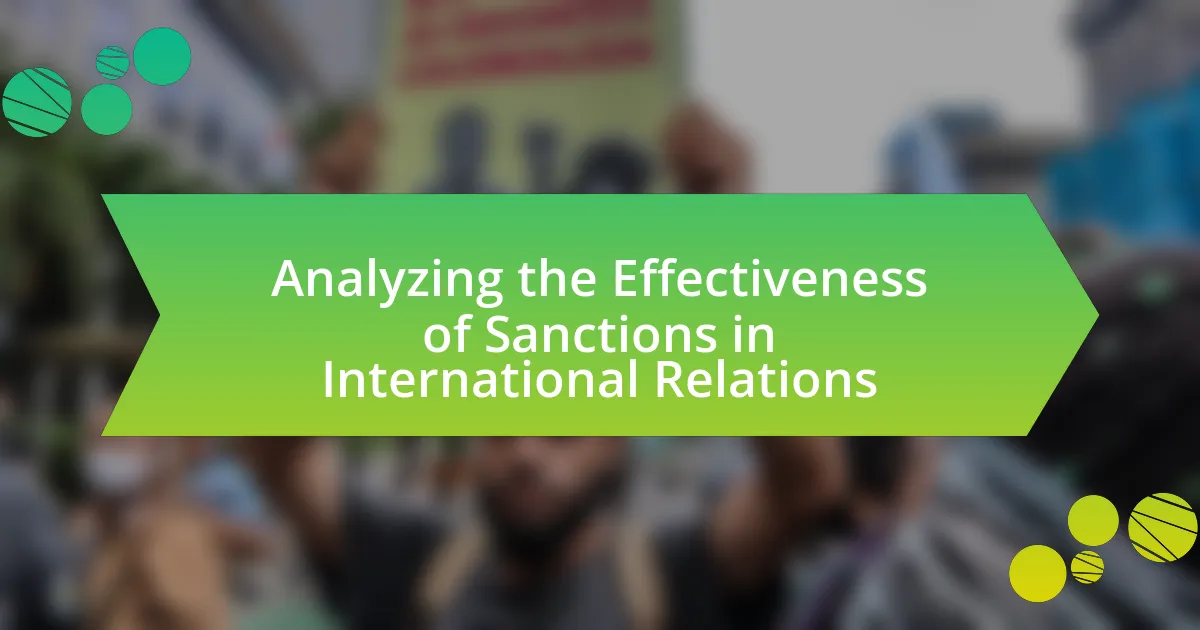International organizations, such as the United Nations Framework Convention on Climate Change (UNFCCC) and the Intergovernmental Panel on Climate Change (IPCC), play a vital role in climate change agreements by facilitating negotiations, providing scientific assessments, and ensuring compliance among member states. They establish frameworks like the Paris Agreement, which aims to limit global warming, and offer financial and technical support to help countries achieve their climate goals. The article explores the functions of these organizations, the challenges they face, and the importance of collaboration and transparency in enhancing global climate action. Additionally, it examines the contributions of regional organizations and the impact of funding on the effectiveness of international climate agreements.

What is the Role of International Organizations in Climate Change Agreements?
International organizations play a crucial role in climate change agreements by facilitating negotiations, setting standards, and providing platforms for cooperation among countries. These organizations, such as the United Nations Framework Convention on Climate Change (UNFCCC), help establish legally binding commitments and frameworks, like the Paris Agreement, which aims to limit global warming to well below 2 degrees Celsius. They also provide technical assistance, financial resources, and data collection to support countries in implementing their climate goals. For instance, the Intergovernmental Panel on Climate Change (IPCC) offers scientific assessments that inform policy decisions, reinforcing the importance of evidence-based approaches in climate action.
How do international organizations contribute to climate change agreements?
International organizations contribute to climate change agreements by facilitating negotiations, providing scientific research, and offering financial and technical support to member countries. For instance, the United Nations Framework Convention on Climate Change (UNFCCC) serves as a platform for countries to discuss and formalize commitments to reduce greenhouse gas emissions. Additionally, organizations like the Intergovernmental Panel on Climate Change (IPCC) deliver critical assessments of climate science, which inform policy decisions. Financial mechanisms, such as the Green Climate Fund, enable developing nations to implement climate adaptation and mitigation strategies, thereby enhancing global cooperation on climate action.
What are the key functions of international organizations in these agreements?
International organizations play crucial roles in climate change agreements by facilitating negotiations, providing technical expertise, and ensuring compliance among member states. They serve as platforms for dialogue, enabling countries to reach consensus on climate action, as seen in the United Nations Framework Convention on Climate Change (UNFCCC) processes. Additionally, these organizations offer scientific assessments and data, such as the Intergovernmental Panel on Climate Change (IPCC) reports, which inform policy decisions. Furthermore, they monitor and evaluate the implementation of agreements, ensuring accountability and transparency, exemplified by the mechanisms established under the Paris Agreement.
How do international organizations facilitate negotiations among countries?
International organizations facilitate negotiations among countries by providing a structured platform for dialogue, establishing common frameworks, and offering technical expertise. For instance, organizations like the United Nations Framework Convention on Climate Change (UNFCCC) create formal settings where countries can discuss climate policies, share best practices, and negotiate binding agreements. The UNFCCC has successfully facilitated major climate agreements, such as the Paris Agreement in 2015, which involved extensive negotiations among 196 countries to limit global warming. This structured approach helps to build trust, align interests, and foster cooperation, ultimately leading to more effective and comprehensive climate action.
Why are international organizations essential in addressing climate change?
International organizations are essential in addressing climate change because they facilitate global cooperation and establish frameworks for collective action. These organizations, such as the United Nations Framework Convention on Climate Change (UNFCCC), provide platforms for countries to negotiate agreements, share best practices, and mobilize resources. For instance, the Paris Agreement, adopted in 2015, exemplifies how international organizations can unite nations under a common goal to limit global warming to well below 2 degrees Celsius. This agreement has been signed by 197 parties, demonstrating the critical role of international organizations in fostering collaboration and commitment among diverse nations to combat climate change effectively.
What unique resources do international organizations provide for climate action?
International organizations provide unique resources for climate action, including funding, technical expertise, and platforms for international cooperation. For instance, the Green Climate Fund, established by the United Nations Framework Convention on Climate Change, allocates financial resources to developing countries to support climate mitigation and adaptation projects. Additionally, organizations like the World Bank offer technical assistance and capacity-building programs to enhance countries’ abilities to implement climate strategies effectively. Furthermore, international organizations facilitate dialogue and collaboration among nations, exemplified by the annual Conference of the Parties (COP) meetings, which serve as critical platforms for negotiating climate agreements and sharing best practices. These resources collectively enhance global efforts to combat climate change.
How do international organizations enhance global cooperation on climate issues?
International organizations enhance global cooperation on climate issues by facilitating dialogue, establishing frameworks for collaboration, and providing platforms for negotiation among member states. For instance, the United Nations Framework Convention on Climate Change (UNFCCC) serves as a critical forum where countries can discuss their climate commitments and share best practices. Additionally, organizations like the World Bank and the International Monetary Fund offer financial resources and technical assistance to support climate initiatives, thereby promoting collective action. The Paris Agreement, adopted under the UNFCCC, exemplifies how international organizations can unify countries around common goals, with 197 parties committing to limit global warming to well below 2 degrees Celsius. This collaborative approach is essential for addressing the complex and transboundary nature of climate change, as it requires coordinated efforts across nations to achieve meaningful progress.

What types of international organizations are involved in climate change agreements?
International organizations involved in climate change agreements include intergovernmental organizations, non-governmental organizations, and regional organizations. Intergovernmental organizations, such as the United Nations Framework Convention on Climate Change (UNFCCC), facilitate international negotiations and agreements like the Paris Agreement. Non-governmental organizations, such as Greenpeace and the World Wildlife Fund, advocate for climate action and influence policy. Regional organizations, such as the European Union, implement collective climate policies among member states. These organizations play critical roles in shaping and enforcing climate change agreements globally.
What are the main categories of international organizations focused on climate change?
The main categories of international organizations focused on climate change include intergovernmental organizations, non-governmental organizations, and multilateral environmental agreements. Intergovernmental organizations, such as the United Nations Framework Convention on Climate Change (UNFCCC), facilitate negotiations and frameworks for climate action among countries. Non-governmental organizations, like Greenpeace and the World Wildlife Fund, advocate for environmental protection and influence policy through research and activism. Multilateral environmental agreements, such as the Paris Agreement, establish legally binding commitments for countries to reduce greenhouse gas emissions. These categories collectively play a crucial role in shaping global climate policy and action.
How do governmental organizations differ from non-governmental organizations in this context?
Governmental organizations differ from non-governmental organizations in the context of climate change agreements primarily in their authority and accountability. Governmental organizations, such as national governments and intergovernmental bodies, possess legal authority to create and enforce policies, allocate funding, and implement regulations related to climate change. For instance, the United Nations Framework Convention on Climate Change (UNFCCC) is a governmental entity that facilitates international negotiations and agreements among countries. In contrast, non-governmental organizations (NGOs) operate independently of government control and focus on advocacy, research, and public awareness. NGOs, like Greenpeace, influence climate policy through activism and lobbying but lack the formal power to enforce agreements. This distinction highlights the differing roles each type of organization plays in shaping and implementing climate change strategies.
What roles do intergovernmental organizations play in climate agreements?
Intergovernmental organizations play crucial roles in climate agreements by facilitating negotiations, providing scientific assessments, and ensuring compliance among member states. For instance, the United Nations Framework Convention on Climate Change (UNFCCC) serves as a primary platform for international climate negotiations, bringing together countries to discuss and implement climate policies. Additionally, organizations like the Intergovernmental Panel on Climate Change (IPCC) deliver comprehensive scientific reports that inform policy decisions, highlighting the urgency of climate action based on empirical data. Furthermore, intergovernmental organizations monitor progress and enforce commitments through mechanisms such as the Paris Agreement’s transparency framework, which requires countries to report on their emissions and climate actions. These roles are essential for fostering international cooperation and accountability in addressing climate change.
How do regional organizations contribute to climate change agreements?
Regional organizations contribute to climate change agreements by facilitating cooperation among member states, providing a platform for negotiation, and promoting the implementation of climate policies. For instance, the European Union has established binding targets for greenhouse gas emissions and has created the Emissions Trading System, which incentivizes reductions in emissions across its member countries. Additionally, regional organizations often mobilize financial resources and technical assistance to support climate initiatives, as seen in the case of the African Union’s Agenda 2063, which emphasizes sustainable development and climate resilience. These collaborative efforts enhance the effectiveness of global climate agreements by ensuring that regional priorities and challenges are addressed within the broader framework of international climate action.
What specific initiatives have regional organizations implemented?
Regional organizations have implemented initiatives such as the European Union’s Emissions Trading System (EU ETS) and the African Union’s Agenda 2063, which focus on reducing greenhouse gas emissions and promoting sustainable development. The EU ETS, established in 2005, is a cap-and-trade system that aims to lower emissions from power plants and industrial facilities by allowing them to buy and sell emission allowances. Meanwhile, Agenda 2063 outlines a vision for sustainable development across Africa, emphasizing climate resilience and environmental sustainability. These initiatives demonstrate the commitment of regional organizations to address climate change through structured frameworks and collaborative efforts.
How do regional organizations address local climate challenges?
Regional organizations address local climate challenges by implementing tailored policies and collaborative initiatives that reflect the specific environmental needs of their regions. For instance, the European Union has established the European Green Deal, which aims to make Europe climate-neutral by 2050 through regulations and funding for sustainable projects. Additionally, organizations like the Association of Southeast Asian Nations (ASEAN) promote regional cooperation on climate resilience, focusing on disaster risk reduction and sustainable resource management. These efforts are supported by data indicating that localized approaches can enhance the effectiveness of climate action, as seen in the Intergovernmental Panel on Climate Change (IPCC) reports highlighting the importance of regional strategies in mitigating climate impacts.

What challenges do international organizations face in climate change agreements?
International organizations face significant challenges in climate change agreements, primarily due to differing national interests and economic priorities. These organizations, such as the United Nations Framework Convention on Climate Change (UNFCCC), struggle to reconcile the varying commitments of member states, which often prioritize economic growth over environmental regulations. For instance, developing countries may resist stringent emissions targets due to concerns about economic development and poverty alleviation, while developed nations may push for more aggressive climate action. Additionally, the lack of binding enforcement mechanisms in many agreements complicates compliance and accountability, leading to inconsistent implementation of climate policies. This dynamic creates a complex negotiation landscape, where achieving consensus becomes increasingly difficult, as evidenced by the challenges faced during the Paris Agreement negotiations in 2015, where countries had to balance their national interests with global climate goals.
What are the main obstacles to effective collaboration among international organizations?
The main obstacles to effective collaboration among international organizations include differing national interests, lack of resources, and bureaucratic inefficiencies. Differing national interests often lead to conflicting priorities, making it challenging for organizations to align on common goals, particularly in climate change agreements where economic and environmental priorities may clash. A lack of resources, both financial and human, hampers the ability of organizations to implement collaborative initiatives effectively. Bureaucratic inefficiencies, such as complex decision-making processes and slow communication, further impede timely and effective collaboration. These factors collectively hinder the potential for cohesive action among international organizations in addressing climate change.
How do political differences among countries impact international agreements?
Political differences among countries significantly impact international agreements by influencing negotiation dynamics, priorities, and compliance levels. For instance, countries with contrasting political ideologies, such as democratic versus authoritarian regimes, often have divergent views on issues like climate change, leading to challenges in reaching consensus. The Paris Agreement exemplifies this, where nations like the United States and China have historically held opposing stances on emissions reductions, affecting the overall effectiveness of the agreement. Furthermore, political differences can result in varying levels of commitment; countries with strong environmental policies may push for stricter regulations, while others prioritize economic growth over environmental concerns, complicating collaborative efforts. These disparities highlight the necessity for international organizations to mediate and facilitate dialogue, ensuring that diverse political perspectives are considered in the formulation and implementation of agreements.
What role does funding play in the effectiveness of international organizations?
Funding is crucial for the effectiveness of international organizations as it directly influences their capacity to implement programs and initiatives. Adequate financial resources enable these organizations to conduct research, facilitate negotiations, and support member states in achieving climate change goals. For instance, the Green Climate Fund, established under the UN Framework Convention on Climate Change, has mobilized over $10 billion to assist developing countries in climate adaptation and mitigation efforts, demonstrating how funding enhances operational capabilities and effectiveness. Without sufficient funding, international organizations may struggle to fulfill their mandates, leading to diminished impact on global climate agreements.
How can international organizations improve their effectiveness in climate agreements?
International organizations can improve their effectiveness in climate agreements by enhancing collaboration among member states and integrating scientific research into policy-making. Strengthened collaboration fosters trust and commitment, as seen in the Paris Agreement, where countries collectively set targets and share progress. Additionally, incorporating scientific data, such as the Intergovernmental Panel on Climate Change reports, ensures that policies are based on the latest climate science, leading to more informed decision-making. This dual approach of collaboration and evidence-based policy can significantly enhance the impact of international climate agreements.
What strategies can be implemented to enhance collaboration and communication?
To enhance collaboration and communication in the context of international organizations and climate change agreements, implementing regular multi-stakeholder forums is essential. These forums facilitate dialogue among governments, NGOs, and the private sector, ensuring diverse perspectives are considered. For instance, the United Nations Framework Convention on Climate Change (UNFCCC) holds annual Conferences of the Parties (COP) that bring together various stakeholders to discuss progress and challenges, fostering a collaborative environment. Additionally, utilizing digital communication platforms can streamline information sharing and enable real-time collaboration, as evidenced by the success of virtual meetings during the COVID-19 pandemic, which allowed continuous engagement despite physical barriers.
How can international organizations better engage with local communities?
International organizations can better engage with local communities by implementing participatory approaches that prioritize local knowledge and needs. This involves actively involving community members in decision-making processes, ensuring their voices are heard, and integrating their insights into climate change strategies. For instance, the United Nations Framework Convention on Climate Change (UNFCCC) emphasizes the importance of local participation in its guidelines, which have been shown to enhance the effectiveness of climate initiatives. Research indicates that projects incorporating local input are 30% more likely to succeed, as they align with the specific cultural and environmental contexts of the communities involved.
What best practices can international organizations adopt for successful climate agreements?
International organizations can adopt several best practices for successful climate agreements, including fostering inclusive participation, establishing clear and measurable targets, and ensuring robust monitoring and accountability mechanisms. Inclusive participation allows diverse stakeholders, including governments, NGOs, and local communities, to contribute to the negotiation process, enhancing legitimacy and buy-in. Clear and measurable targets, such as those outlined in the Paris Agreement, provide a framework for assessing progress and maintaining momentum. Robust monitoring and accountability mechanisms, exemplified by the Transparency Framework in the Paris Agreement, ensure that commitments are tracked and that parties are held accountable for their actions. These practices have been shown to enhance the effectiveness of climate agreements, as evidenced by the increased participation and commitment levels observed in agreements that incorporate these elements.
How can transparency and accountability be improved in climate negotiations?
Transparency and accountability in climate negotiations can be improved by implementing standardized reporting frameworks and enhancing stakeholder engagement. Standardized reporting frameworks, such as those established by the Paris Agreement, require countries to provide consistent and comparable data on greenhouse gas emissions and climate actions, which fosters accountability. Enhanced stakeholder engagement, including the involvement of civil society and local communities, ensures diverse perspectives are considered, promoting transparency in decision-making processes. Research by the United Nations Framework Convention on Climate Change (UNFCCC) indicates that increased participation leads to more robust accountability mechanisms, as stakeholders can hold negotiators accountable for their commitments.
What lessons can be learned from past climate agreements to inform future actions?
Past climate agreements highlight the importance of binding commitments and transparency to enhance accountability among nations. For instance, the Kyoto Protocol established legally binding targets for developed countries, demonstrating that enforceable agreements can drive emissions reductions. Additionally, the Paris Agreement’s emphasis on nationally determined contributions (NDCs) illustrates the effectiveness of flexible, country-specific targets that encourage participation from a broader range of nations. Historical data shows that countries with clear reporting mechanisms, like those in the European Union’s Emissions Trading System, have achieved more significant emissions reductions compared to those without such frameworks. These lessons underscore the necessity of combining binding commitments with flexible approaches and robust monitoring systems to inform future climate actions effectively.






